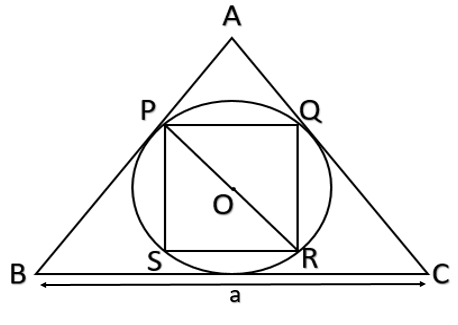
A circle is inscribed in an equilateral triangle of side a. The area of any square inside the triangle is $\dfrac{{{a}^{2}}}{k}$. Find value of k.
Answer
563.1k+ views
Hint: Now we know that the radius of the in-circle of the equilateral triangle is given by $\dfrac{side}{2\sqrt{3}}$ . Hence we can also find the diameter of the in-circle. Now the diameter is nothing but the diagonal of the square. Hence using the Pythagoras theorem in square we can find the value of ${{\left( side \right)}^{2}}$ . Now the area of the square is also given by ${{\left( side \right)}^{2}}$ hence we have the area of the square.
Complete step by step answer:
Now we have that a circle is inscribed in an equilateral triangle and the square is inscribed in the triangle. Consider the figure.

Now since the circle with center O is inscribed in the triangle we can say that the circle is in-circle of the triangle ABC.
Now ABC is an equilateral triangle with side a.
Now we know that the radius of the in-circle for an equilateral triangle is given by $\dfrac{side}{2\sqrt{3}}$ .
Hence the radius of the circle with center O is given by $\dfrac{a}{2\sqrt{3}}$ .
Now we know that the diameter is twice the radius.
Hence the diameter of the circle with radius $\dfrac{a}{2\sqrt{3}}$ is $\dfrac{a}{\sqrt{3}}$ .
Now from the figure we know that PR is the diameter of the circle.
Hence we have $PR=\dfrac{a}{\sqrt{3}}...........................\left( 1 \right)$
Now we know that PQRS is a square.
Hence $\angle PQR={{90}^{\circ }}$. This means $\Delta PQR$ is a right angle triangle.
Hence by Pythagoras theorem $P{{Q}^{2}}+Q{{R}^{2}}=P{{R}^{2}}$
Now since PQRS is a square we have PQ = QR.
Hence $2P{{Q}^{2}}=P{{R}^{2}}$
Now substituting the value of PR we get, $2P{{Q}^{2}}={{\left( \dfrac{a}{\sqrt{3}} \right)}^{2}}$
Hence we get $P{{Q}^{2}}=\dfrac{a}{6}$ .
Now we know that the area of square is given by ${{\left( side \right)}^{2}}$
Hence the area of the square inscribed is $\dfrac{a}{6}$ .
So, the correct answer is “k = 6”.
Note: Now note that the circle inscribed inside the triangle is called in-circle and if the triangle is inscribed inside the circle then the circle is called circumcircle. Now the radius of circumcircle of equilateral triangle is given by $\dfrac{a}{\sqrt{3}}$ while the radius of in-circle is given by $\dfrac{a}{2\sqrt{3}}$ Hence do not make a mistake by taking the radius of the in-circle as $\dfrac{a}{\sqrt{3}}$ .
Complete step by step answer:
Now we have that a circle is inscribed in an equilateral triangle and the square is inscribed in the triangle. Consider the figure.

Now since the circle with center O is inscribed in the triangle we can say that the circle is in-circle of the triangle ABC.
Now ABC is an equilateral triangle with side a.
Now we know that the radius of the in-circle for an equilateral triangle is given by $\dfrac{side}{2\sqrt{3}}$ .
Hence the radius of the circle with center O is given by $\dfrac{a}{2\sqrt{3}}$ .
Now we know that the diameter is twice the radius.
Hence the diameter of the circle with radius $\dfrac{a}{2\sqrt{3}}$ is $\dfrac{a}{\sqrt{3}}$ .
Now from the figure we know that PR is the diameter of the circle.
Hence we have $PR=\dfrac{a}{\sqrt{3}}...........................\left( 1 \right)$
Now we know that PQRS is a square.
Hence $\angle PQR={{90}^{\circ }}$. This means $\Delta PQR$ is a right angle triangle.
Hence by Pythagoras theorem $P{{Q}^{2}}+Q{{R}^{2}}=P{{R}^{2}}$
Now since PQRS is a square we have PQ = QR.
Hence $2P{{Q}^{2}}=P{{R}^{2}}$
Now substituting the value of PR we get, $2P{{Q}^{2}}={{\left( \dfrac{a}{\sqrt{3}} \right)}^{2}}$
Hence we get $P{{Q}^{2}}=\dfrac{a}{6}$ .
Now we know that the area of square is given by ${{\left( side \right)}^{2}}$
Hence the area of the square inscribed is $\dfrac{a}{6}$ .
So, the correct answer is “k = 6”.
Note: Now note that the circle inscribed inside the triangle is called in-circle and if the triangle is inscribed inside the circle then the circle is called circumcircle. Now the radius of circumcircle of equilateral triangle is given by $\dfrac{a}{\sqrt{3}}$ while the radius of in-circle is given by $\dfrac{a}{2\sqrt{3}}$ Hence do not make a mistake by taking the radius of the in-circle as $\dfrac{a}{\sqrt{3}}$ .
Recently Updated Pages
Two men on either side of the cliff 90m height observe class 10 maths CBSE

What happens to glucose which enters nephron along class 10 biology CBSE

Cutting of the Chinese melon means A The business and class 10 social science CBSE

Write a dialogue with at least ten utterances between class 10 english CBSE

Show an aquatic food chain using the following organisms class 10 biology CBSE

A circle is inscribed in an equilateral triangle and class 10 maths CBSE

Trending doubts
Why is there a time difference of about 5 hours between class 10 social science CBSE

Write a letter to the principal requesting him to grant class 10 english CBSE

What is the median of the first 10 natural numbers class 10 maths CBSE

The Equation xxx + 2 is Satisfied when x is Equal to Class 10 Maths

Which of the following does not have a fundamental class 10 physics CBSE

State and prove converse of BPT Basic Proportionality class 10 maths CBSE




